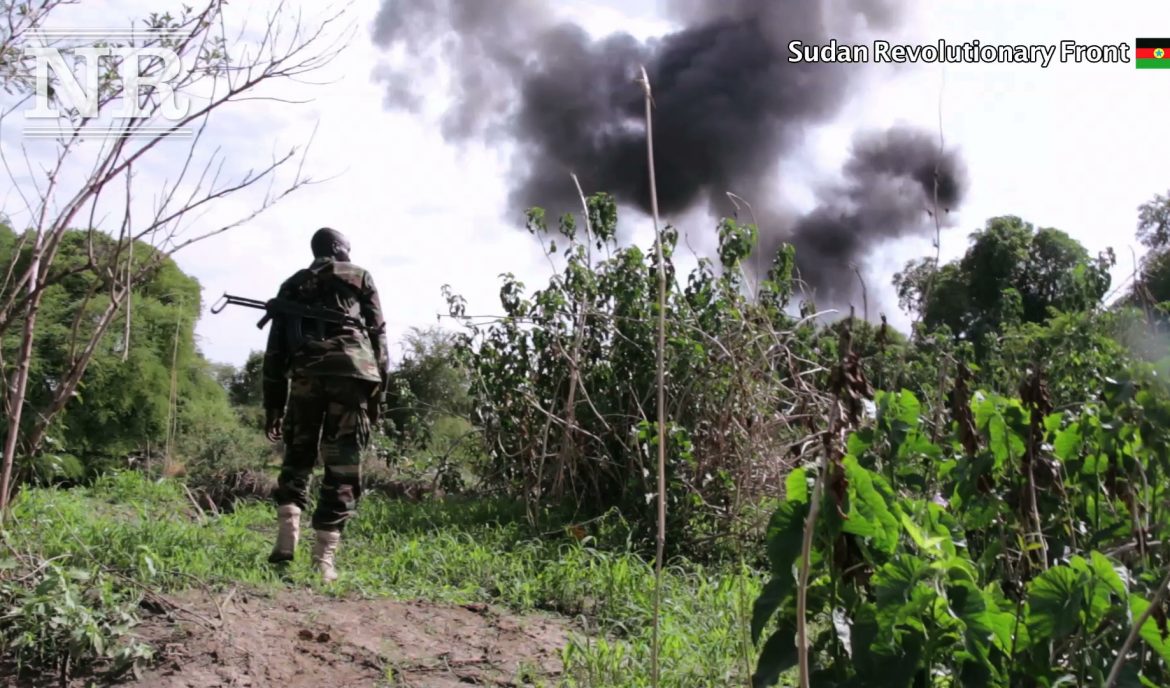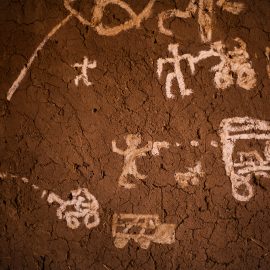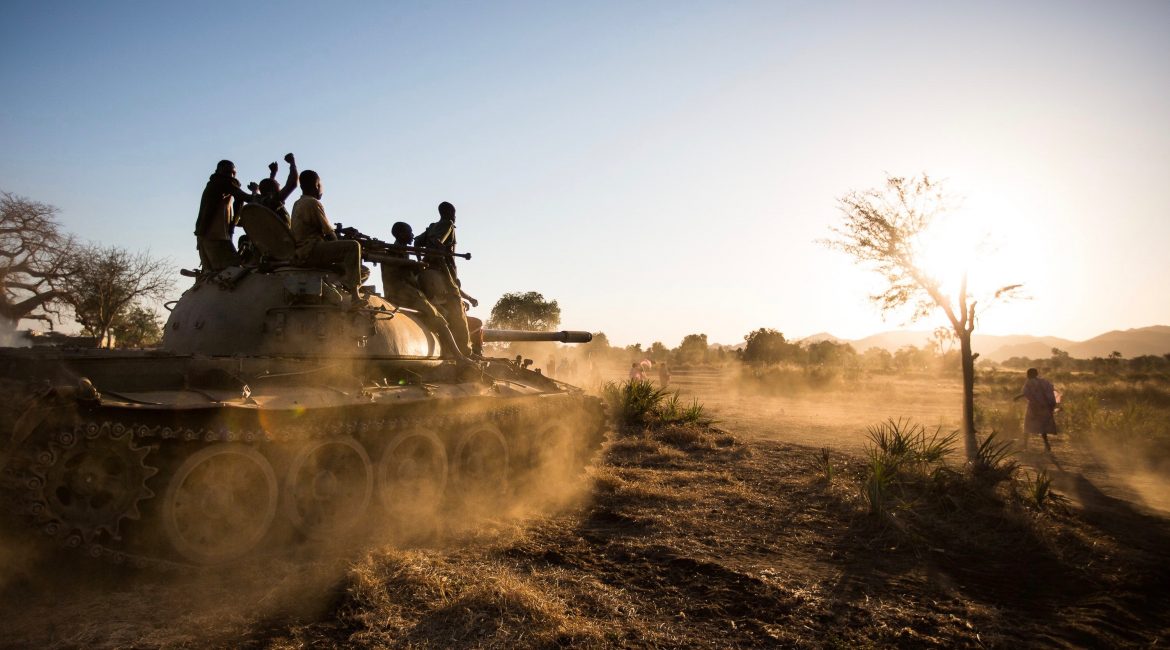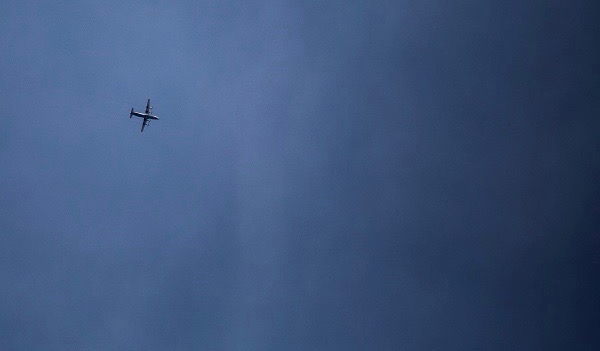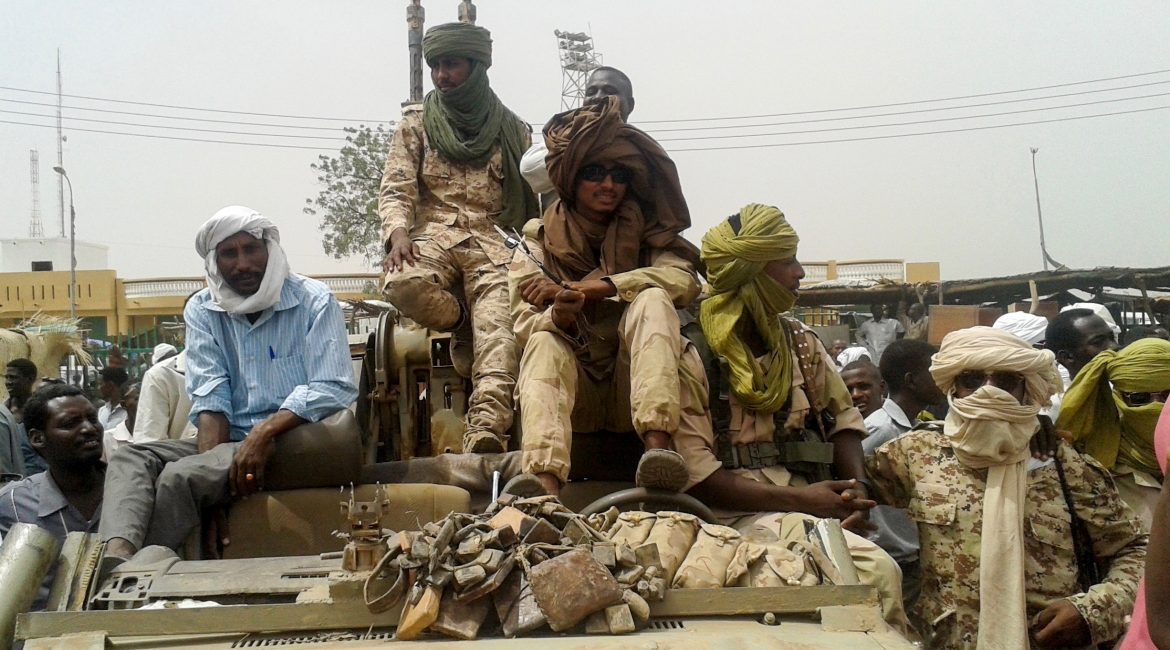November 3, 2014 – Almost one year ago, Sudanese government forces and Sudanese rebels squared off in a massive ground battle for Rashad in South Kordofan.
Both government and rebel forces recorded this exclusive combat footage during the clash. The film offers a unique opportunity to understand the dynamics on both sides of this bloody, protracted conflict.
The following text reflects the outcome of an independent assessment of the military equipment visible in the footage made by Conflict Armament Research.
At the end of the rainy season, just as the grounds dried, marking the beginning of the fighting season, the young Sudan Revolutionary Front (SRF) underwent its most ambitious operation to date, aiming to expand control over valuable territory with the with the power of the newly united rebel groups. The fresh alliance brought together fighters from JEM, SLA-Mini Minawi, SLA-Abdulhuahid and SPLA-N.
The battle for Rashad prompted the Sudanese government to redouble its efforts. After the conflict the government quickly invested in experienced Janjaweed fighters and armed them to wage war against the SRF and civilians in the rebel areas. Khartoum rebranded the former Janjaweed the Rapid Support Force (RSF). Although their initial attacks on rebel forces in the Nuba Mountains were driven back, they made aggressive advances in June toward the end of the fighting season and promise to play a large role when fighting commences in November 2014.
A close analysis of the scenes offers valuable insights into both armies’ tactics, as well as the justifications – real or manufactured – they use to fight. It also lays a foundation for this year’s fighting season, which is just beginning.
WHY THEY FIGHT
The first scenes in the film are of the leaders of both the Sudan Armed Forces (SAF) and the SRF rallying their troops and communities to war.SPLM-N commander Abdelaziz Al-Hilu explains that for the SRF, the war represents the ultimate means to freedom, equality and coexistence in a “New Sudan.” Despite diverging ideologies and different backgrounds, the most powerful rebel movements from Darfur (the Sudan Liberation Army’s factions lead by Minni Minawi and bdul Wahid Mohamed al Nur, SLA-MM and SLA-AW, and the Justice and Equality Movement, JEM), SPLM-North and dissidents from opposition parties (the Democratic Unionist Party and the National Umma Party) progressively fine-tuned their voice and established the SRF as an opposition-platform on November 12, 2011, with the objective of sparking regime-change in Sudan through military pressure. Since then, the different forces within the SRF have participated in joint-operations in Darfur and South Kordofan.
Militarily, the SRF is currently engaged on three fronts: the Nuba Mountains in South Kordofan, Blue Nile and Darfur. The Nuba Mountains front most accurately reflects the dimensions of the Revolutionary Front’s struggle, with the three Darfurian affiliated movements actively engaged in coordinated military offensives alongside SPLM-N, under a Joint Military Command.
For the regime, war in Sudan’s peripheries presents both a threat and an opportunity. After South Sudan’s secession, the regime must use the war as an opportunity to further tighten its control over the country. This has been pursued in part by reducing room for political non-violent opposition and deploying rhetoric of the (allegedly threatened) Islamic identity of Sudan to mobilize new forms of support and new recruits. Although they can’t be regarded as an official government spokesmen, the SAF commanders’ rhetoric in the moments preceding the battle illustrate the dominant ideology in SAF’s ranks: the themes of martyrdom and the religious identity are perfectly reflected in the sentences of the militia leader talking in the opening of the video and of SAF Major General Ahmed Bahar Ahmed, who refers to enemies as ‘miscreants.’ He further depicts them as causeless criminals and calls for retaliation in the name of God.
SAF: ONE TACTIC, SEVERAL THEATERS
SAF’s operational approach in South Kordofan mirrors their original approach in Darfur, and is also replicated in Blue Nile. The government forces typically launch offensives with large ground contingents, who gather soldiers and militia or paramilitary groups (often referred as mujahideen, when recruited within religious groups in Khartoum, or Popular Defense Forces (PDF) when recruited from local tribes), which are directly supplied with arms and ammunition by Sudan’s intelligence agencies. Since most of the affiliated militias aren’t equipped with vehicles, they rely on SAF operated trucks for mobility. Those visible in the footage, including Land-Cruiser technical vehicles (some mounted with 12.7 mm DshK-type machine-guns, SPG-9-type 73 mm recoilless guns, and multiple 107 mm rocket launchers), Buffalo-type 4×4 vehicles, MAN trucks (7 Ton 6×6 type), GIAD assembled copies of MAN trucks (Type FE 420 and LE 18.200 4×4) and Ural (Type 4320) trucks, provide a fairly comprehensive sample of SAF’s road transportation.
The tactics, techniques and procedures in the video mirror standard SAF practice. As ground forces slowly advance, the area is shelled first with artillery (D-30 122 mm howitzers and two Type 59 battle-tanks with 100 mm cannons) and then by aerial means. Once the battlefield has been cleared by shelling and bombing, ground forces engage.
In particular, helicopter gunships equipped with 30 mm canons and UB-16 launchers for S5 55 mm air-to-ground unguided rockets, which SAF has used in various locations throughout Darfur, play a supporting role. SAF’s fleet of military helicopters was fully imported from Russia between 2001 and 2010. Overall, 44 Mi-24 helicopters were delivered in successive waves, and between 2011 and 2013 the government ordered an additional 24 Mi-24 helicopters (and 16 Mi-8 transport helicopters), totaling a contract of an estimated 150 to 200 million dollars. Although not particularly effective, gunship helicopters and aircrafts (both Antonov cargo planes converted into bombers and jet-fighters) provide the government with substantive supremacy.
Neither SAF aerial offensives, conducted on a near daily basis in the SRF controlled areas (often in isolation from ground attacks) nor long distance shelling have delivered conclusive military victories for the government. However, these tactics have had devastating effects on the living conditions of the local population who are constantly under mortal unpredictable threat. In South Kordofan alone, the conflict has directly affected some 800,000 individuals, many of whom have endured severe food insecurity, water shortages and a general lack of fundamental services since 2011.
Artillery and air attacks are not the only cause of suffering for the civilian population, but they are the dominant feature of war in the Nuba Mountains, as suggested by the rate of aerial bombardments (more than 550 aerial bombardments were recorded in the SPLM-N controlled areas of South Kordofan during the first six months of 2014, with an exponential increase in May and June) and shelling (more than 1,200 artillery or rocket shells exploded in the same period[R1] ) during the Decisive Summer operation. Deliberate targeting of two hospitals (the Mother of Mercy Hospital in Gidel, near Kauda, on 1st May and MSF hospital in Frandala, in Buram County, on 16 June) by SAF planes and the approximately 150,000 new displacements recorded since April 2014 could provide additional examples for the same conclusion: names of the operations change, SAF’s tactical approach and devastation repeats itself.
SRF MERGES DIFFERENT FORCES, TACTICS
Rebel forces employ distinct yet complementary tactical approaches in South Kordofan. While SPLM-North forces follow a more conventional fighting style, to some extent mirroring SAF’s, JEM (and other Darfurian movements) units are smaller and equipped with less artillery. To compensate, they rely on fast-reacting mobile units that quickly attack and retreat. To paraphrase the words of an SPLM-N officer: while SPLM-North engages in battle as an army, using both artillery and infantry forces in an orderly manner, JEM operates in a more flexible and unpredictable manner, using guerrilla techniques and technical vehicles like a modern cavalry force.
JEM’s vehicles are fighting tools: almost exclusively 4×4 Toyota Landcruiser pick-up trucks, often with the top of the cabin cut-off. In addition to serving as a mean of transportation, and many are equipped with mounted machine-guns (like the 12.7 x 108 mm DShK-type that is shown firing at the SAF Mi-24 in the video) or anti-tank recoilless guns. SPLM-North vehicles, on the other hand, are mainly used for moving equipment and troops. The memory of long campaigns fought by troops that had walked for days during the SPLA struggle remains strong, and contributes to the SPLM-N’s strategy and fighting habits. Since 2011, the SPLA-N has acquired a significant fleet of vehicles and fully integrated ground transportation despite the challenging terrain, especially during the rainy season. To some extent, increased cooperation with JEM and other Darfur movements has contributed to a change in SPLM-N’s fighting techniques and tactics, too.
Much like their vehicles, both sides employ similar weaponry on the ground. In fact, it is not unusual for both groups to use identical weapons, confirming that SAF has been unintentionally the primary supplier of military equipment, not only to affiliated militias, but also to its enemies. The SRF lacks SAF’s aerial bombardment capabilities, a serious distinction given the massive aerial bombardment SAF conducts.
Both the SAF and SRF use 7.62 x 39 mm AK-pattern assault-rifles (Soviet-manufactured models and Chinese variant Type 56-1 and Type 56-2s); 7.62 x 54 mm PKM-type machine-guns (of which one variant, the ‘Mokhtar’, is manufactured in Sudan); 12.7 x 108 mm DShK-type heavy machine-guns (of which a Sudanese-manufacture variant, the ‘Khawad’, exists); SPG-9 recoilless anti-tank guns; 107 mm rocket-launchers (the Sudanese produce one called the ‘Taka’); and D-30 type 122 mm Howitzer canons (including the Sudanese manufactured model known as the ‘Khalifa’). Although the footage does not focus much on the ammunition, similarities can be seen in SAF and SRF stocks (a combination of both imported ammunition and Sudanese manufactured items, such as small caliber ammunition and mortar bombs). Sudan claims that its state-run weapons manufacturer, the Military Industry Corporation, manufactures the majority of models of weapons that SAF and its affiliate forces use in military operations in South Kordofan. This runs small-caliber ammunition to main battle tanks, with the exception of air assets and more sophisticated long-range artillery systems.
SHIFTING FRONT LINES
Since the beginning of the conflict, military operations have taken place in the northern part of South Kordofan, including the strategic areas of Dilling and Rashad, where the SRF controls some enclaves bordering the road-axis that links South to North Kordofan, and some key government logistical hubs.
Between early 2013 and early 2014 the military campaign in South Kordofan proved to be mostly favor the SRF. Over several months, SLA-AW and SLA-MM troops joined JEM and SPLM-N, both of which had been deployed in the area since 2011. SRF troops inflicted several defeats on SAF and affiliated groups, while consolidating their positions, capturing military equipment and pushing the frontline to North Kordofan. The government’s summer offensive and the eruption of the civil war South Sudan ushered in a new phase of the war in the beginning of 2014.
Six months after this video was recorded, Rashad County remains under heavy military pressure. In April 2014 government forces engaged in a “Decisive Summer” offensive to defeat the rebellions in South Kordofan, Darfur and Blue Nile. To launch the offensive in South Kordofan, SAF mobilized significant caches of additional equipment, in particular long-range artillery systems from Khartoum and Al Obeid (such as WS-01 multiple rocket launcher systems, 2s1 self-propelled guns and 122mm Howitzer systems), and troops backed by the RSF. The unit, almost 6,000 strong, extensively trained, heavily equipped and recruited from ideological circles close to the regime, the RSF played an important role in the Decisive Summer Offensive and contributed to SAF’s increased power to advance and destroy on the ground.
To prepare for the ‘Decisive Summer’ the government deployed the RSF to counter JEM’s offensive in North Kordofan in 2013. The RSF was charged with the main objective to prevent the front-line from moving northward. After having consolidated its rear bases, SAF moved from a defensive to an offensive posture, first in North and South Darfur (where the RSF fought between February and March 2014) and in the ‘Two Areas’ of South Kordofan and Blue Nile, from April onwards.
The military balance did not greatly shift in the Nuba Mountains region. During the first three months most of the fighting of the summer campaign concentrated in the southeastern part of the state. RSF troops conducted successful battles in Alatmor, al-Hamra, Abujibeha County, Talodi County and Daldoko, which is near Kadugli. SAF attacked as well as in Rashad, Buram and Delami areas (where SAF attacked the RSF).
The South Sudanese civil war that broke out in Juba in mid-December 2013 created immediate ripple effects as it spread to Unity and Upper Nile states, and neighboring South Kordofan and Blue Nile. The Sudan’s People Liberation Army, (SPLA), now the South Sudanese national army, splintered into two opposed forces, one loyal to the government and one supporting what became the SPLA-in Opposition. Several battles between the government’s forces (also including recently integrated troops of the South Sudan Liberation Army, fighting alongside SAF in South Kordofan until April 2013) and the in-Opposition troops took place in Unity and Upper Nile. Proximity to the conflict in South Sudan inevitably had consequences for the SRF, the populations living in rebel controlled areas and the refugees who had left South Kordofan, many of whom had fled the bombardment at home for the comparative safety of northern South Sudan.
SILENCE SPEAKS
The silence that follows the blast of explosions and shouts when the battle ends is emblematic of the civil war in South Kordofan, representing the desolation left by the conflict and the suffering of the communities. Everyday, they are confronted with huge battles involving armies of thousands, ground and air military equipment worth several hundred millions dollars, hundreds of bombs dropped from the sky and enormous amounts of resources diverted from development. It is a conflict fought far from the media spotlight, reduced to a silent war despite the forced displacement of more than two million people and a lingering humanitarian crisis.
The SRF troops silent walk alongside dead soldiers, reminiscent of the military equilibrium that has become a gloomy routine in Sudan. This conflict is likely to continue. Right now, there is no real prospect of resolution. Despite three years of intense fighting, neither side has managed to weaken its enemy, nor can either expect to achieve quick victory.
The military dimensions of the war in South Kordofan remain similar to those at the start of the war in 2011. With a decisive military solution unlikely in the near future and a grounded diplomatic mediation, no credible political alternatives seem to exist. Not only has political debate in Sudan become less frequent in recent years, but also, the government’s repeated promise to focus solely on the military option appears to already be in effect. SAF spokesperson, al-Sawarmi Khaled Saad, declared during a TV interview on 2 July 2014 that confrontations with the rebels in the coming period were expected to be more violent. In such a context, the government’s refusal to recognize the legitimacy of SRF as a political actor suggests only prolonged war and the silent desolation that follows.

